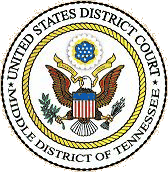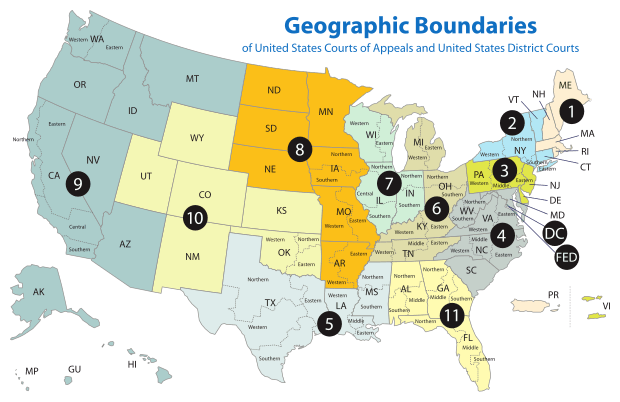United States District Court for the Middle District of Tennessee
| United States District Court for the Middle District of Tennessee | |
|---|---|
| (M.D. Tenn.) | |
 | |
|
| |
| Location |
Estes Kefauver Federal Building and U.S. Courthouse
More locations |
| Appeals to | Sixth Circuit |
| Established | June 18, 1839 |
| Judges | 4 |
| Chief Judge | Waverly D. Crenshaw Jr. |
| Officers of the court | |
| U.S. Attorney | Donald Q. Cochran |
|
www | |
The United States District Court for the Middle District of Tennessee (in case citations, M.D. Tenn.) is the federal trial court for most of Middle Tennessee. Based at the Estes Kefauver Federal Building and United States Courthouse in Nashville, it was created in 1839 when Congress added a third district to the state. Tennessee—along with Kentucky, Ohio, and Michigan—is located within the area covered by United States Court of Appeals for the Sixth Circuit, and appeals are taken to that court (except for patent claims and claims against the U.S. government under the Tucker Act, which are appealed to the Federal Circuit).
Donald Q. Cochran is the United States Attorney.
The Middle District has three divisions. (1) The Columbia Division comprises the counties of Giles, Hickman, Lawrence, Lewis, Marshall, Maury, and Wayne. (2) The Northeastern Division comprises the counties of Clay, Cumberland, DeKalb, Fentress, Jackson, Macon, Overton, Pickett, Putnam, Smith, and White. (3) The Nashville Division comprises the counties of Cannon, Cheatham, Davidson, Dickson, Houston, Humphreys, Montgomery, Robertson, Rutherford, Stewart, Sumner, Trousdale, Williamson, and Wilson.
History
The United States District Court for the District of Tennessee was established with one judgeship on January 31, 1797, by 1 Stat. 496.[1][2] The judgeship was filled by President George Washington's appointment of John McNairy. Since Congress failed to assign the district to a circuit, the court had the jurisdiction of both a district court and a circuit court. Appeals from this one district court went directly to the United States Supreme Court.
On February 13, 1801, in the famous " Midnight Judges" Act of 1801, 2 Stat. 89, Congress abolished the U.S. district court in Tennessee,[2] and expanded the number of circuits to six, provided for independent circuit court judgeships, and abolished the necessity of Supreme Court Justices riding the circuits. It was this legislation which created the grandfather of the present Sixth Circuit. The act provided for a "Sixth Circuit" comprising two districts in the State of Tennessee, one district in the State of Kentucky and one district, called the Ohio District, composed of the Ohio and Indiana territories (the latter including the present State of Michigan). The new Sixth Circuit Court was to be held at "Bairdstown" in the District of Kentucky, at Knoxville in the District of East Tennessee, at Nashville in the District of West Tennessee, and at Cincinnati in the District of Ohio. Unlike the other circuits which were provided with three circuit judges, the Sixth Circuit was to have only one circuit judge with district judges from Kentucky and Tennessee comprising the rest of the court. Any two judges constituted a quorum. New circuit judgeships were to be created as district judgeships in Kentucky and Tennessee became vacant.[3]
The repeal of this Act restored the District on March 8, 1802, 2 Stat. 132.[2] The District was divided into the Eastern and Western Districts on April 29, 1802.[1] On February 24, 1807, Congress again abolished the two districts and created the United States Circuit for the District of Tennessee. On March 3, 1837, Congress assigned the judicial district of Tennessee to the Eighth Circuit. On June 18, 1839, by 5 Stat. 313, Congress divided Tennessee into three districts, Eastern, Middle, and Western.[1][2][4] Again, only one judgeship was allotted for all three districts. On July 15, 1862, Congress reassigned appellate jurisdiction to the Sixth Circuit. Finally, on June 14, 1878, Congress authorized a separate judgeship for the Western District of Tennessee, at which time President Rutherford B. Hayes appointed David M. Key as judge for the Eastern and Middle Districts of Tennessee. The first judge to serve only the Middle District of Tennessee was John J. Gore, appointed by Warren G. Harding.
Current composition of the court
| # | Title | Judge | Duty station | Born | Term of service | Appointed by | ||
|---|---|---|---|---|---|---|---|---|
| Active | Chief | Senior | ||||||
| 22 | Chief Judge | Waverly D. Crenshaw Jr. | Nashville | 1956 | 2016–present | 2017–present | — | Obama |
| 19 | District Judge | Aleta Arthur Trauger | Nashville | 1945 | 1998–present | — | — | Clinton |
| 23 | District Judge | William L. Campbell Jr. | Nashville | 1969 | 2018–present | — | — | Trump |
| 24 | District Judge | Eli J. Richardson | Nashville | 1967 | beg. 2018 | — | — | Trump |
| 14 | Senior Judge | Thomas Anderton Wiseman Jr. | inactive | 1930 | 1978–2003 | 1984–1991 | 1995–present | Carter |
| 15 | Senior Judge | John Trice Nixon | inactive | 1933 | 1980–1998 | 1991–1998 | 1998–present | Carter |
| 18 | Senior Judge | Todd J. Campbell | inactive | 1956 | 1995–2016 | 2005–2012 | 2016–present | Clinton |
Former judges
| # | Judge | State | Born–died | Active service | Chief Judge | Senior status | Appointed by | Reason for termination |
|---|---|---|---|---|---|---|---|---|
| 1 | Morgan Welles Brown | TN | 1800–1853 | 1839–1853 | — | — | Jackson | death |
| 2 | West Hughes Humphreys | TN | 1806–1882 | 1853–1862 | — | — | Pierce | impeachment and conviction |
| 3 | Connally Findlay Trigg | TN | 1810–1880 | 1862–1880 | — | — | Lincoln | death |
| 4 | David M. Key | TN | 1824–1900 | 1880–1895 | — | — | Hayes | retirement |
| 5 | Charles Dickens Clark | TN | 1847–1908 | 1895–1908 | — | — | Cleveland | death |
| 6 | Edward Terry Sanford | TN | 1865–1930 | 1908–1923 | — | — | T. Roosevelt | elevated to Supreme Court |
| 7 | John J. Gore | TN | 1878–1939 | 1923–1939 | — | — | Harding | death |
| 8 | Xenophon Hicks | TN | 1872–1952 | 1923–1928 | — | — | Harding | appointment to 6th Cir. |
| 9 | Leslie Rogers Darr | TN | 1886–1967 | 1939–1940 | — | — | F. Roosevelt | seat abolished |
| 10 | Elmer David Davies | TN | 1899–1957 | 1939–1957 | 1954–1957 | — | F. Roosevelt | death |
| 11 | William Ernest Miller | TN | 1908–1976 | 1955–1970 | 1961–1970 | — | Eisenhower | appointment to 6th Cir. |
| 12 | Frank Gray, Jr. | TN | 1908–1978 | 1961–1977[Note 1] | 1970–1977 | 1977–1978 | Kennedy | death |
| 13 | Leland Clure Morton | TN | 1916–1998 | 1970–1984 | 1977–1984 | 1984–1998 | Nixon | death |
| 16 | Thomas Aquinas Higgins | TN | 1932–2018 | 1984–1999 | — | 1999–2018 | Reagan | death |
| 17 | Robert L. Echols | TN | 1941–present | 1992–2007 | 1998–2005 | 2007–2010 | G.H.W. Bush | retirement |
| 20 | William Joseph Haynes Jr. | TN | 1949–present | 1999–2014 | 2012–2014 | 2014–2017 | Clinton | retirement |
| 21 | Kevin H. Sharp | TN | 1963–present | 2011–2017 | 2014–2017 | — | Obama | resignation |
- ↑ Recess appointment; formally nominated on January 15, 1962, confirmed by the United States Senate on February 7, 1962, and received commission on February 17, 1962.
Chief judges
Chief judges have administrative responsibilities with respect to their district court. Unlike the Supreme Court, where one justice is specifically nominated to be chief, the office of chief judge rotates among the district court judges. To be chief, a judge must have been in active service on the court for at least one year, be under the age of 65, and have not previously served as chief judge. A vacancy is filled by the judge highest in seniority among the group of qualified judges. The chief judge serves for a term of seven years or until age 70, whichever occurs first. The age restrictions are waived if no members of the court would otherwise be qualified for the position.
When the office was created in 1948, the chief judge was the longest-serving judge who had not elected to retire on what has since 1958 been known as senior status or declined to serve as chief judge. After August 6, 1959, judges could not become or remain chief after turning 70 years old. The current rules have been in operation since October 1, 1982.
Succession of seats
|
|
|
|
| ||||||||||||||||||||||||||||||||||||||||||||||||||||||||||||||
|
|
|
| ||||||||||||||||||||||||||||||||||||||||||
See also
Notes
- 1 2 3 Asbury Dickens, A Synoptical Index to the Laws and Treaties of the United States of America (1852), p. 391.
- 1 2 3 4 U.S. District Courts of Tennessee, Legislative history, Federal Judicial Center.
- ↑ The Honorable Harry Phillips, "History of the Sixth Circuit Archived 2007-01-11 at the Wayback Machine.".
- ↑ Alfred Conkling, A Treatise on the Organization, Jurisdiction and Practice of the Courts of the United States (1842), p. 42.
